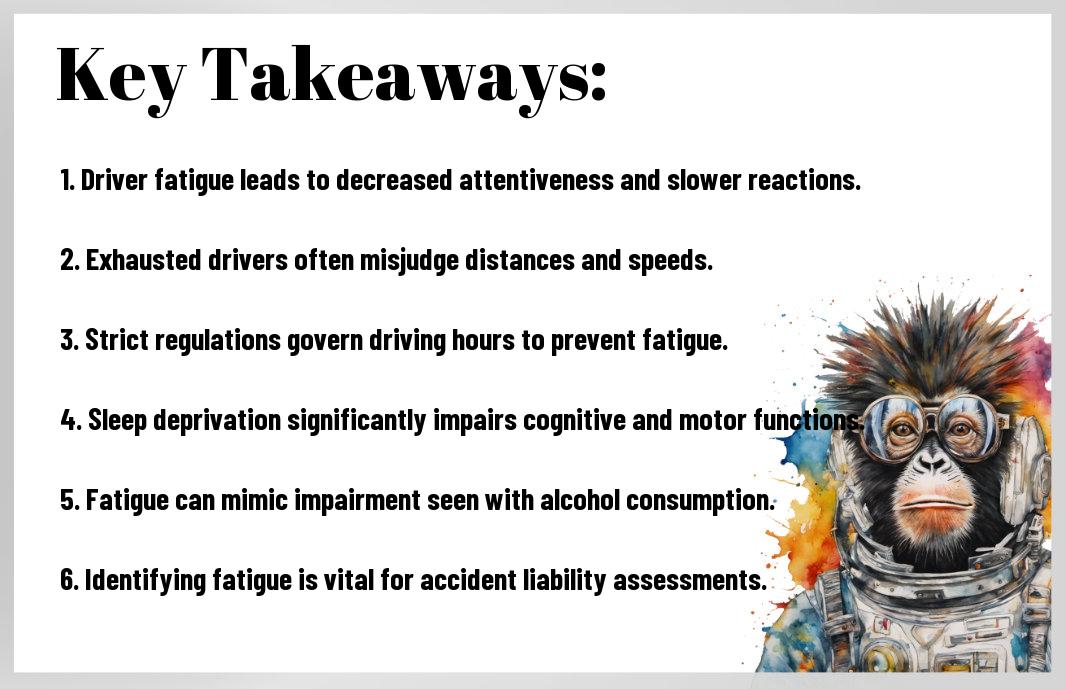It’s vital to understand how driver fatigue can significantly impact truck accident cases. When you’re behind the wheel of a massive vehicle, the consequences of fatigue can be catastrophic. Fatigued drivers may experience decreased attention, slower reaction times, and impaired decision-making, all of which can lead to severe accidents. This blog post will guide you through the signs of driver fatigue, its legal implications, and how it can affect your case if you’re involved in an accident. Understanding these factors is vital for ensuring your safety and pursuing justice effectively.
The Nature of Driver Fatigue
To understand the impact of driver fatigue on truck accident cases, it’s crucial to recognize that fatigue affects your cognitive abilities and motor skills. Fatigue can impair your decision-making, reaction times, and overall alertness, leading to hazardous driving conditions. Whether caused by long hours on the road, irregular sleep patterns, or stressful driving environments, fatigue can have severe consequences on your performance behind the wheel.
Causes of Driver Fatigue
An array of factors contributes to driver fatigue, including prolonged driving without breaks, extended work hours, and inadequate rest. Factors like poor sleep quality, medical conditions, and the monotony of long stretches on the highway can exacerbate fatigue levels, making it crucial to stay aware of how these elements affect your performance.
Symptoms and Effects on Driving Performance
Between the various symptoms of driver fatigue, you may experience drowsiness, decreased focus, and impaired judgment. Such symptoms can lead to slower reaction times and a higher likelihood of accidents. It is vital to be aware of how your body and mind respond when you’re fatigued, as the consequences can be severe.
Driving while fatigued significantly increases the risk of accidents due to diminished alertness and slower reaction times. You may find yourself frequently yawning, struggling to maintain your lane, or struggling to focus on the road ahead. These symptoms can lead to catastrophic outcomes if you ignore them. Always prioritize your well-being and take breaks to combat driver fatigue, ensuring a safer driving experience for you and others on the road.
The Impact of Driver Fatigue on Truck Operations
Clearly, driver fatigue significantly hinders your ability to operate a truck safely. As a driver, prolonged hours on the road can lead to decreased attention, slow reaction times, and impaired decision-making capabilities. The demanding nature of truck operations often forces you to push your limits, increasing the likelihood of accidents caused by fatigue. Understanding how fatigue affects your performance is crucial for ensuring not only your safety but also that of others on the road.
Statistics on Truck Accidents Related to Fatigue
Driver fatigue is a leading factor in many truck accidents. Recent studies indicate that more than 70% of long-haul truck drivers report experiencing fatigue while driving. Additionally, approximately 30% of fatal truck accidents involve a driver who was asleep or drowsy at the wheel, highlighting the urgency of addressing this issue.
Case Studies Demonstrating Fatigue-Related Incidents
One effective way to understand the implications of driver fatigue is through real-world case studies.
- Case Study 1: A truck driver fell asleep while driving on a highway, resulting in a collision that injured 5 people and caused over $1 million in damages.
- Case Study 2: During a 24-hour shift, a driver reported that fatigue led to a 15-car pileup, claiming 3 lives and injuring 20 others.
- Case Study 3: In a survey, 25% of drivers admitted to nodding off at the wheel at least once within the past year.
Accidents like these illustrate the serious consequences of fatigue-related incidents. By examining these studies, you can gain insight into the importance of managing your fatigue levels effectively. Prioritizing adequate rest and adhering to safety regulations can significantly reduce your risk of becoming another statistic on the road. Stay vigilant and prioritize your well-being to help ensure safe truck operations.
Legal Implications of Driver Fatigue in Truck Accidents
You may find that driver fatigue significantly impacts the legal landscape surrounding truck accidents. Fatigue can lead to a violation of safety regulations, affecting liability determinations in accident cases. Understanding how driver fatigue factors into legal implications is crucial for anyone involved in trucking operations or accident claims, as it can shape the outcome of investigations and litigation.
Liability and Responsibility
Before addressing liability, it’s important to note that both the truck driver and their employer share responsibility for maintaining safe driving practices. If a fatigued driver causes an accident, they may be held liable for negligence. However, the trucking company could also face liability if they failed to enforce regulations or encourage rest periods, highlighting the shared responsibility in these tragic incidents.
Regulatory Standards and Compliance
With strict regulatory standards in place, the trucking industry is required to comply with regulations aimed at reducing driver fatigue. Failure to adhere to these rules can lead to significant legal repercussions for both the driver and the trucking company.
Regulatory standards established by the Federal Motor Carrier Safety Administration (FMCSA) set limits on driving hours and *mandatory rest periods* to combat driver fatigue. These regulations aim to enhance road safety and minimize the risk of accidents. Non-compliance can expose truck drivers and their employers to liability in the event of an accident. Additionally, consistent adherence to these regulations is vital, as *violations can strengthen claims* against negligent parties, impacting settlements and litigation outcomes significantly.
Preventive Measures and Solutions
All stakeholders in the transportation industry must prioritize preventive measures to combat driver fatigue. Implementing training programs, establishing clear driving schedules, and promoting a culture of safety are crucial steps. Creating an environment where drivers are encouraged to take necessary breaks can significantly reduce the likelihood of accidents. Additionally, companies should regularly assess their policies and equipment to ensure they align with the latest safety standards.
Technology and Innovation in Driver Monitoring
Preventive measures also include leveraging advanced technology to monitor driver behavior. Innovations such as real-time fatigue detection systems and wearable devices can alert you or your drivers when fatigue levels become alarming. By integrating these technologies, you’ll enhance safety and minimize risks associated with tiredness while driving.
Best Practices for Fleet Management
Fleet management plays a significant role in mitigating risks associated with driver fatigue. You should implement structured schedules that allow adequate rest between shifts and conduct regular assessments of driver performance to identify concerning patterns in behavior.
Plus, ensuring that your drivers receive adequate training on fatigue awareness is vital. Incorporate mandatory rest periods into driving schedules, and monitor hours to prevent exhaustion. Regular performance evaluations can detect signs of fatigue before they escalate into dangerous situations. This proactive approach not only enhances safety but also promotes your drivers’ overall well-being, contributing positively to your fleet’s efficiency and reputation.
Addressing Driver Fatigue Through Education
Once again, tackling driver fatigue starts with effective education. By providing comprehensive training and resources, you can empower drivers to understand and recognize the signs of fatigue, helping them make informed decisions about their driving schedules. This awareness can ultimately lead to safer roads and fewer accidents.
Training Programs for Drivers
Along with education, implementing structured training programs for drivers is vital. These programs should focus on strategies to manage fatigue, including proper rest, sleep hygiene, and the importance of taking breaks during long hauls. By incorporating these elements, you can foster a culture of safety and responsibility.
Raising Awareness in the Industry
Education is also necessary in raising awareness throughout the industry about the dangers of driver fatigue. You play a part in promoting a culture that values safety over deadlines, ensuring that all stakeholders recognize the effects of fatigue on performance and decision-making.
With a proactive approach to raising awareness in the trucking industry, you can help mitigate the risks associated with driver fatigue. Regular workshops, seminars, and informational campaigns can highlight the serious consequences of operating a vehicle while fatigued. By emphasizing productive communication between drivers, dispatchers, and management, you promote an environment that encourages adequate rest and responsible scheduling, resulting in a safer working landscape for everyone involved.

Conclusion
Now that you understand the significant impact of driver fatigue in truck accident cases, it’s vital to recognize its implications for both safety and legal accountability. When you are on the road, being aware of how drowsiness can impair judgment and reaction times is important for you as a driver or for those responsible for managing truck drivers. Addressing fatigue through proper scheduling and rest can not only help prevent accidents but also protect you from potential legal consequences. Staying informed about these risks empowers you to make safer choices on the road.









